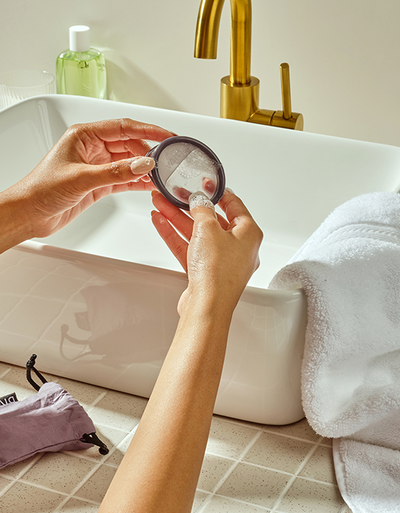
In this article /

Quand j’ai enfin eu mes premières règles à presque 15 ans, j’ai ressenti un immense soulagement, rapidement suivi d’une douleur sourde et irradiante dans l’abdomen, le bas du dos et les jambes, une douleur qui allait au-delà des crampes et de la raideur qui étaient typiques pour moi. Je suis atteinte de paralysie cérébrale (PC). Tout comme il n’y a pas deux règles identiques, il n’y a pas deux expériences de PC identiques, mais pour moi, cela signifie que j’utilise un fauteuil roulant la plupart du temps et que j’ai besoin de cannes pour marcher. J’ai des problèmes d’équilibre et je dois faire face à des spasmes fréquents dans mes jambes. Je souffre également de scoliose, une courbure de la colonne vertébrale qui me fait m’asseoir et me lever en biais. J’ai l’habitude de me déplacer à une vitesse différente de celles de mon entourage, mais je n’avais aucune raison de m’attendre à ce qu’il me faille autant de temps pour atteindre le stade des premières règles.
J'avais commencé à craindre que, tout comme l'espace vide dans mon carnet de bébé sous la rubrique « Les premiers pas de bébé », mes règles n'arriveraient mystérieusement jamais.
Mon médecin ne m’avait été d’aucune aide. Au contraire, il semblait satisfait de voir la nature retarder ce qu’il considérait comme un développement inutile, refusant de me faire passer des examens gynécologiques ou de me prescrire des tests, une tendance qui s’est poursuivie lorsque j’ai dû faire face à des problèmes de fertilité suivis de règles excessivement abondantes après la naissance de mes jumeaux.
Cette expérience n’est malheureusement pas unique à moi. Selon une étude récente, 49,6 % des personnes handicapées ont subi des mauvais traitements de la part du personnel médical et 69 % d’entre elles ont rencontré d’autres obstacles importants lorsqu’elles ont essayé d’accéder aux soins de santé reproductive [1] .
Les barrières médicales n'étaient pas les seules difficultés auxquelles je devais faire face en tant que personne handicapée ayant ses règles. Malheureusement, tout comme les toilettes soi-disant accessibles où je devais faire de la gymnastique pour changer mes serviettes hygiéniques imbibées de sang, j'ai découvert que la plupart des produits à ma disposition n'étaient pas conçus en fonction de mon corps. Les produits menstruels faciles à utiliser étaient difficiles à trouver pour une personne ayant ses règles alors qu'elle était handicapée.
Les serviettes hygiéniques se regroupaient et se déplaçaient constamment, ce qui n'était pas bien conçu pour celles qui passaient leurs journées assises. La serviette hygiénique moyenne n'offrait pas non plus une couverture suffisante, ce qui signifiait que je devais utiliser des serviettes maxi volumineuses et inconfortables, que mon flux soit abondant ou léger. Comme je ne suis pas assise droite, les fuites se produisaient toujours d'un côté, quelle que soit l'épaisseur de la serviette. Les tampons auraient pu me permettre de gagner du temps avant que cela n'arrive, mais je devais me tenir debout et utiliser mes deux mains pour les insérer, ce qui entraînait de fréquentes chutes sur le sol de ma salle de bains. Le TINA [2] , un dispositif d'insertion de tampon inclusif, aurait peut-être facilité la tâche, mais le coût et l'inconfort des tampons, ainsi que leur incapacité à gérer mes jours les plus abondants sans les changer toutes les heures, en faisaient un mauvais choix pour moi.
J’ai écarté les sous-vêtements menstruels, car le nombre de lessives et la nécessité de déshabiller entièrement ma moitié inférieure à chaque changement me semblaient trop lourds. Bien que j’aie aimé l’idée d’une surface plus grande, d’un volume réduit et d’une plus grande durabilité, j’étais parfaitement consciente que les options de soins menstruels les plus durables ne sont pas toujours durables pour un corps handicapé.
J'avais hâte d'essayer les coupes menstruelles, une option qui m'a permis de trouver un équilibre entre mes besoins et ma passion pour la réduction de mon impact environnemental. Mais si les tampons avaient été si difficiles à utiliser, aurais-je pu supporter une coupe ? Sur un coup de tête, j'en ai commandé une et j'ai été surprise de constater à quel point elle me convenait. Contrairement aux tampons, je pouvais l'insérer en étant assise et j'ai adoré le fait qu'elle me donnait une idée plus précise de ma perte de sang, même si mon médecin n'était pas inquiet du fait que ma coupe se remplissait toutes les heures. Le seul hic était le retrait, mes doigts ayant souvent du mal à briser le joint. En tant que personne handicapée, la conception de base de la coupe menstruelle n'était pas inclusive et n'était pas une option de coupe menstruelle conviviale pour moi et je suis sûre que pour beaucoup d'autres. Le jour où j'ai réalisé que j'avais besoin d'une meilleure option, j'ai dû appeler mon mari pour qu'il m'aide à la retirer, nous essayions tous les deux de ne pas paniquer alors que nos jumeaux frappaient à la porte de la salle de bain.
Finalement, j'ai découvert le Disque DIVA . Il était plus facile à insérer que les coupes, il ne nécessitait qu'un simple pliage, et il était rapide et indolore à retirer car il ne dépendait pas de la succion pour rester en place. Le meilleur de tout était la boucle sur le devant, qui facilitait le retrait, même lorsque mes doigts étaient réticents. Il m'a également aidé à conserver mon énergie en tenant plus longtemps entre les changements. Pour la première fois, mes règles semblaient gérables.
J'ai encore du mal à faire prendre au sérieux mes saignements excessifs, mais au moins je n'ai plus de mal à les contenir. Là où mes médecins ne parviennent pas à faire face à mes problèmes, mes Disque DIVA Alors que je continue à militer pour des soins accessibles, c'est un soulagement de le faire depuis un siège de fauteuil roulant propre.










